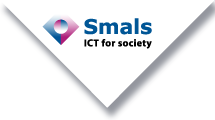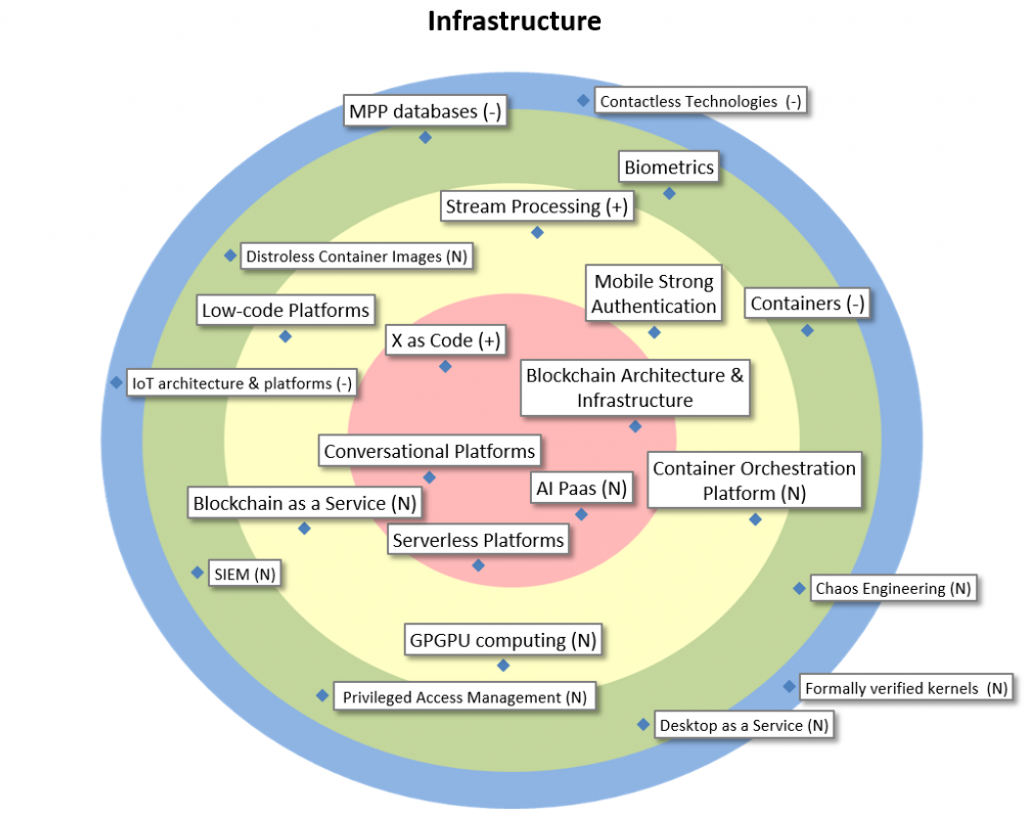| X as Code |
Instead of physical hard-wiring of system components, all infrastructure and platforms become virtualized, configurable via software and thus, essentially, code. This enables enormous flexibility in the datacenter. Also known as “Software Defined Anything”. |
| Blockchain Architecture & Infrastructure |
To bring a blockchain application live, we also need to consider architectural and infrastructural aspects |
| Conversational Platforms |
Conversational platforms support the development of conversational interfaces based on intent and entity recognition, context handling, exception handling, messaging platform connectors and monitoring/analytics. |
| Serverless Platforms |
This architecture allows to simply send code, based on handler templates, to a ‘Function Platform as a Service’ (FPaaS). It can then immediately be run without any server or middleware setup. Scalability, robustness, and many other non-fuctional requirements are handled by the platform. |
| AI Paas |
AI Platform as a Service (PaaS) provides AI model building tools, APIs and associated middleware that enable the building/training, deployment and consumption of machine learning models running on prebuilt infrastructure as cloud services. |
| Mobile Strong Authentication |
The ability to strongly authenticate a user on a mobile device with minimal friction. Special attention goes to the context of conversational interfaces (especially speech and new specifications like Web Authentication / FIDO2. |
| Stream Processing |
The flow of (incoming) data, and not an application’s (or cpu’s) regular control flow, govern its architecture and runtime. This a new paradigm, sometimes even driven by new hardware, and opposes the traditional way of working with fluxes. Also known as Dataflow Architecture and related to EDA. |
| Low-code Platforms |
Platforms or frameworks on which developers, and sometimes also business stakeholders, can more rapidly build applications. Delivered through PaaS or as libraries, they are often characterized by the use of graphical programming methods, for GUI but also for the logic. |
| Blockchain as a Service |
A blockchain network in the cloud. This allows to abstract away the infrastructural complexity of blockchain networks. However, trust in the cloud company is required. It might be useful for Smals to offer such a platform to its customers in the longer term. |
| GPGPU computing |
General Purpose GPU Computing is the use of GPU hardware to perform general purpose computations. Especially useful for analysis of very large datasets or for highly parallellizable tasks, e.g. in context of machine learning / AI |
| Container Orchestration Platform |
Containers have become the dominant means of deploying applications on Cloud infrastructure. As such, orchestration and management of containers has become crucial for maintainability and control, allowing an organization to effectively employ thousands of containers in production. |
| Containers |
Containers are the new Cloud: They are lightweight virtualizations, using far less resources than typical virtual machines for nearly the same level of isolation. They’re also more ‘single-purpose’ and ‘throw-away’. They are used extensively to support applications on Cloud Platforms. |
| Biometrics |
Biometrics are metrics related to human characteristics (e.g. fingerprint, DNA, facial recognition). Biometrics authentication can be used as access control and finally finds acceptance as a strong authentication on mobile devices. |
| MPP databases |
Massively Parallel Processing databases. An MPP database is a database that is optimized to be processed in parallel for many operations to be performed by many processing units at a time. |
| Distroless Container Images |
Minimal kernel and functionality needed to make a container work for the application it is supposed to support. Decreases weight and increases security. |
| SIEM |
In the field of computer security, security information and event management software products and services combine security information management and security event management. They provide real-time analysis of security alerts generated by applications and network hardware. |
| Privileged Access Management |
Privileged Access Management (PAM) refers to a class of solutions that help secure, control, manage and monitor privileged access to critical assets. |
| Desktop as a Service |
A service offering that deploys a virtualized desktop experience, delivered to a customer on demand from a remotely hosted location. |
| Chaos Engineering |
The usage of experimental, potentially destructive failure or fault injection testing to find unknown points of failure within a complex IT system. It is often utilized to proactively prove resilience, to eliminate potential sources of system downtime. |
| Contactless Technologies |
Transmission technologies not requiring physical contact between transceivers, such as, NFC, RFID, Bluetooth Low Energy, and most techniques used in IoT devices. |
| IoT architecture & platforms |
These systems allow user-friendly management of IoT endpoints, and include dataflow control and security. |
| Formally verified kernels |
The use of formally verified kernels increases the security of operation systems / hypervisors. Best known example is seL4. |

